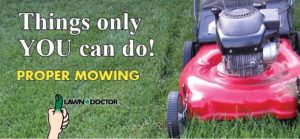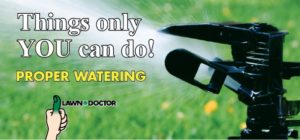 Proper Mowing
Proper Mowing
There are two things that, as a homeowner, you can do to drastically affect the overall appearance of your lawn. Good mowing and watering practices are crucial to a lush, green lawn. This is a game of competition. You want to make things favorable for the grass and unfavorable for the weeds.
Mow High
There is a fight for sun. If the grass doesn’t shade the weed, the weed will shade the grass. Sun is food. Food is strength and life. Shade is weakness, disease and death. Grass will shade the weeds only if it is tall enough. The shade of tall, dense turf will prevent essential light from reaching most weeds, and will aid in the destruction of new baby weed seedlings. Your lawn should be at least 3” tall after mowing.
Mow Often
Your lawn should be cut often enough to never chop off more than 1/3 of the grass blade in a single mowing to return it to a 3” height. MYTH: “If I mow short it will be longer until I have to mow again.” FALSE! Your grass needs blades for photosynthesis (convert sunshine into sugar) to feed the roots. When you whack the blades off, the grass has to RACE to make more blades to make sugar. It then grows amazingly fast. This fast growth uses up a lot of the grass’s stored sugar and weakens the plant. It is now vulnerable to disease and pests! Grass maintained at the proper height is healthier and can use the extra sugar to make rhizomes (more grass plants) thus thickening the turf.
Mow With a Sharp Blade
Mowing with a dull blade gives the lawn a ragged gray appearance after cutting as it tears and shreds the blades instead of cutting them cleanly. These shredded tips turn brown and die causing brown areas. Also, the shredded tips are open wounds for diseases to enter the plant.
Grass-Cycling
Finally, when mowing, be sure to leave the clippings on the lawn. It adds organic matter and nutrients back into the soil. Heavy grass clippings being left on the lawn will only occur if you are mowing too short or when you don’t mow often enough. Should heavy grass clippings occur they should be removed from the lawn as they can smother the turf below.
 Proper Watering
Proper Watering
Proper, consistent watering is essential in keeping a green lawn during the hot summer months.
How Can I Tell If My Lawn Needs Water
A “thirsty” lawn turns from the normal green color to a purple-bluish color. In these areas, the grass blades will not spring back if you walk across the lawn and your footprints will be visible. This is the first sign of “wilt” and indicates a need for water.
If the lawn does not receive water soon, it begins to go dormant and turn brown. Once this happens, it takes a lot of water to bring the color back to the plant. This requires the grass plant to use large amounts of stored energy, greatly weakening it and making it susceptible to disease.
Water Deeply, Not Daily
Deep and infrequent watering maintains a healthy root system and reduces weed infestation (as opposed to light and frequent irrigation, which promotes shallow roots and germination of weed seeds). Watering daily for 15 – 20 minutes will cause the grass roots to stay in the top inch or two of soil, a hot day will quickly dry the soil and much of the grass will brown. Weeds and weed seedlings love a daily watering. It’s just what they need to get a good start.
Lawns need about an inch to an inch and a half of water per week to maintain color. Watering an hour per area every other day with a pulsating sprinkler should give the best results during the hot summer months. This should water down to a soil depth of about 6”- 8”. You can test your sprinkler’s output and consistency by placing flat-bottom cups or cans within the sprinkler pattern and measure the water over a given time. Make adjustments as necessary so the entire lawn is watered evenly.
The Best Time To Water
The best time to water is in the early morning, usually between the hours of 4am – 9am. This is the best time to avoid losing water to evaporation. You can water in the early afternoon, just be aware that it will take more water to get the same results. Avoid watering in the evening and at night, as this can lead to an increase in some lawn diseases.
